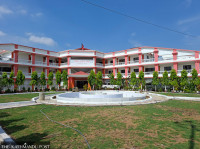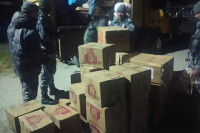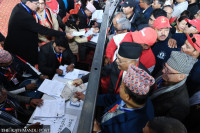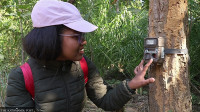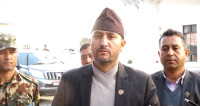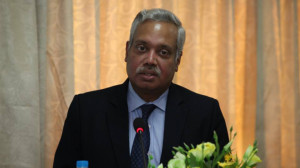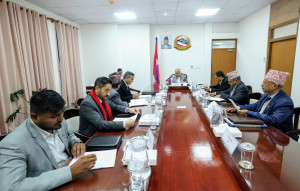National
163 Nepalis deported from US in six months
Majority entered via illegal routes; traffickers remain unidentified as victims refuse to file complaints.
Matrika Dahal
Most Nepalis deported from the United States since President Donald Trump began his second term in January are from Dang, Rukum East, and Rukum West, according to immigration and police data.
Of the 163 Nepalis deported from 28 districts, 51 were from Dang, 30 from Rukum West, and 13 from Rukum East. The majority of those returned are from western Nepal.
Other deportees included nine from Salyan, seven from Myagdi, six each from Parbat, Banke, and Rolpa, five from Baglung, and four from Sindhupalchok. Kathmandu, Jajarkot, and Dolakha each had three cases, while Kaski and Kailali each had two. One person each from Kanchanpur, Gorkha, Jumla, Jhapa, Doti, Dolpa, Dhankuta, Parsa, Makwanpur, Mustang, Morang, Sindhuli, and Sunsari was deported.
Most deportees had entered the US through organised smuggling networks by paying large sums to use illegal migration routes known as donkey routes. These migrants passed through several countries before arriving in the US.
Officials at Nepal’s Immigration Office at Tribhuvan International Airport and the Anti-Human Trafficking Bureau confirmed that most deportees had used these routes, facilitated by international trafficking networks.
Since Trump began his second term on January 20, 2025, US authorities have deported 146 men and 17 women to Nepal. The Trump administration adopted a strict deportation policy targeting undocumented immigrants from countries including Nepal.
Of the total, 45 Nepalis were deported on chartered flights, while the rest were sent back on commercial flights. On March 5, 2025, eight Nepalis—seven men and one woman—were flown to Nepal on a chartered flight. Three months later, on June 6, another 32 men and five women were returned on another chartered flight.
The latest chartered flight, Omni Air International (call sign N-486AX), was initially expected to carry 46 deportees, but only 37 arrived. US officials informed their Nepali counterparts that others on the list would be deported in upcoming flights.
According to a police official, those who cooperated were sent back on regular flights, while individuals with criminal records or those who resisted deportation were removed via chartered aircraft based on the severity of their offence.
The Anti-Human Trafficking Bureau has been questioning deportees upon arrival at Kathmandu airport in a bid to identify trafficking networks. Although many admit they paid large sums to reach the US, they remain unwilling to name the individuals or groups that facilitated their journey.
“Still, we are starting to understand patterns—where the deportees are from, their financial background, and age group. They admit they paid money, but no one talks about the smuggling networks,” said a police officer.
Investigations reveal that smuggling groups charge as much as Rs10 million to take people to the US through illegal channels over several months.
Senior Superintendent of Police Krishna Pangeni, chief of the Bureau, said returnees occasionally mention the name of those who arranged their journey.
“None of them file complaints. They don’t consider themselves victims,” Pangeni said. “They think those agents got them to the US, so why prosecute them? Without formal complaints, it’s difficult to take legal action, but we are continuing the investigation. Any returnee cooperating with a complaint would help identify and dismantle these networks.”
Following Trump’s return to office, US Immigration and Customs Enforcement (ICE) expanded its enforcement actions. The agency has identified 1,445,549 undocumented migrants for deportation, including many from Mexico, El Salvador, India, Guatemala, Honduras and Venezuela.
US Immigration and Customs Enforcement has intensified arrests of those with final deportation orders, focusing on individuals who entered the US after June 24, 2015, and were ordered to leave.
An estimated 3,500 Nepalis are on ICE’s deportation list. Of these, about 2,000 are on Temporary Protected Status (TPS), though nearly 8,000 Nepalis currently live in the US under TPS. The number of deportees has sharply increased since Trump began his second term.
The United States Department of Homeland Security (DHS) terminated Temporary Protected Status (TPS) for Nepali nationals, further tightening immigration policies affecting thousands of individuals and students alike. In a Federal Register notice published in the first week of June, DHS said that the TPS designation for Nepal will officially end at 11:59 pm on August 5, 2025.
Between 2021 and 2024, a total of 140 Nepalis were deported.




 17.12°C Kathmandu
17.12°C Kathmandu
